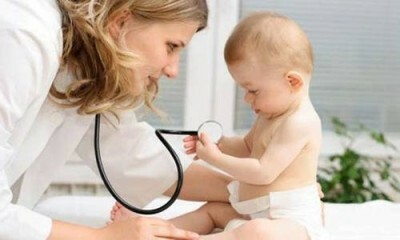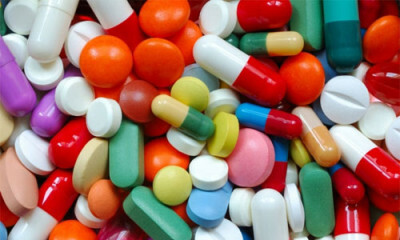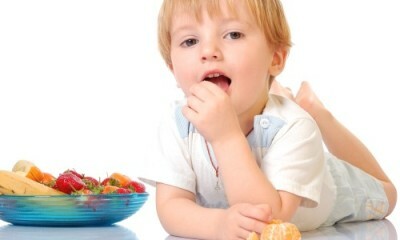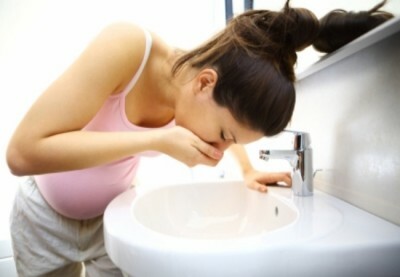1 Why does dysbiosis occur in children?
Children's dysbacteriosis is a serious problem when there is a violation in the composition of microflora and the balance between microorganisms gradually begins to change. The number of pathogenic organisms and those that are conditionally pathogenic, begins to increase rapidly. At the same time, healthy and healthy bacteria die. In this case, the dysbacteriosis in the child becomes the cause of numerous gastrointestinal disorders, the level of immunity begins to drop sharply, anemia develops and other serious health problems may arise.

Recommended to read
- What to drink from dysbacteriosis when taking antibiotics
- Treatment of colitis of the intestines at home
- Symptoms and treatment of acute enteritis in adults
- Effective remedy for gastritis and stomach ulcer
Symptoms of dysbacteriosis can be very diverse and in children of different ages,differently. At the same time, health problems will differ due to taking antibiotics, improper nutrition, or as a result of the impact of poor ecology. It is interesting that dysbiosis in children up to a year occurs much more often than in older age, carries a greater risk to health and has some features of the course that all parents should know in order to prevent the development of complications.
Problems with the composition of microflora and the development of dysbiosis in children under one year can be caused by the following factors:
- infectious-type diseases( eg, Staphylococcus aureus, dysentery and others);
- of the child started to breast feed late enough, and then there was a very sharp weaning;
- artificial feeding;
- lactating mother observes the wrong diet;
- mother or child takes medication, especially antibiotics;
- allergy of food character is observed;
- a woman is very much nervous, which is transmitted to the child;The
- breastfed child has very weak immunity and is affected by poor ecology.
-
 IMPORTANT TO KNOW! Gastritis? Ulcer? To have a stomach ulcer not turned into cancer, drink a glass. ..Read the article & gt; & gt;
IMPORTANT TO KNOW! Gastritis? Ulcer? To have a stomach ulcer not turned into cancer, drink a glass. ..Read the article & gt; & gt;
After the child is 1 year old, he may have other causes and signs of dysbiosis. To the reasons it is possible to carry unhealthy nutrition of the child, the use of many fatty, fried foods and sweets, worms, frequent colds and much more. If the child is older than 12 months, the dysbacteriosis may begin to manifest itself after a different kind of intestinal infection, a chronic illness or due to too long intake of drugs, especially antibiotics. Very poorly affect the baby's intestines and hormonal drugs.
If we talk about school age, then in this case there are additional factors that can cause dysbacteriosis. In particular, this puberty, too frequent stress and anxiety. Very great harm to the body can bring all sorts of operations on the intestines or on the stomach in the child. Dysbiosis of the intestine causes vegetovascular dystonia.
2 The main symptoms of
Symptoms of dysbiosis are not very pronounced in children, so many parents can confuse with other disorders of the gastrointestinal tract.

If the child has problems with the microflora, then in addition to the usual signs, the following is observed:
-
 Gastroenterologist. IMPORTANT: "I beg, if you began to worry about abdominal pain, heartburn, nausea, do not do gas. .."Read more & gt; & gt;
Gastroenterologist. IMPORTANT: "I beg, if you began to worry about abdominal pain, heartburn, nausea, do not do gas. .."Read more & gt; & gt;
- the child quickly gets tired and has a bad state of health;
- the skin becomes very dry;
- hair and nails become weak and brittle;
- the child is nervous without reason and becomes very irritable.
In addition, you can talk about other, more serious signs of dysbiosis in children at an early age:
- there are all sorts of problems with stool, constipation followed by diarrhea;
- there are colic, bloating and flatulence;
- severe attacks of pain in the abdomen;
- in the mouth there is a metallic taste;
- begins to dry the skin and may develop dermatitis;
- has problems with the immune system, it becomes weak, which leads to numerous colds.
In infants, the symptoms of the disease may not appear immediately after the onset of the problem, but after a while. In most cases, the first symptoms can occur no earlier than a month. You can understand this by the fact that the child ceases to gain weight, he has lost his appetite. At the same time, there are problems with the stool, it becomes very fluid and can have a greenish color.
If the child is slightly older than the year, then the number of acts of defecation increases slightly. Some children ask for a toilet immediately after a meal or after a short time. It is worth noting that the chair becomes quite liquid, and in it you can see not completely digested pieces of food.
ADVICE FROM THE MAIN GASTROENTEROLOGIST
Korotov SV: "I can recommend only one remedy for the rapid treatment of Ulcer and Gastritis, which is now recommended by the Ministry of Health. .." Read testimonials & gt; & gt;
Symptoms of childhood dysbiosis will depend entirely on the extent to which the disease is developing.
To date, experts have noted 4 levels of development of dysbiosis in children:
- It is characterized by a slight decrease in the number of beneficial microorganisms, the pathogenic flora does not yet develop. The child is concerned only with two symptoms: too frequent colds and lack of appetite, or he is very bad.
- Characterized by the onset of growth of pathogenic bacteria. Then the level of gas formation increases, diarrhea has a very unpleasant and sharp odor, long constipation can occur.
- Diarrhea becomes chronic, gradually increasing colic and flatulence. The child is very often sick, it all annoys. If the baby is not 1 year old, then the first signs of rickets begin to appear.
- The most dangerous stage is the development of dysbiosis. In the intestinal tract, the number of pathogenic bacteria begins to increase very rapidly. These bacteria can without any problem at any time provoke the appearance of more serious diseases with the gastrointestinal tract. Due to the fact that the food is not completely digested, it starts to release a large number of toxins, and the first signs of chronic poisoning can quickly appear. Diarrhea in this case the child does not stop and has an unpleasant putrefactive smell.
3 Prevention
Prevention of dysbacteriosis plays a very important role, because in this way you can avoid the development of many problems. Prevention of dysbiosis first of all is a healthy lifestyle and a correct, timely and healthy diet. Do not abuse medicines, especially antibiotics. Use them only if necessary.
4 Methods of treatment
Regardless of the stage of development of dysbacteriosis in a child, the problem should be approached in a complex way and combine both the traditional treatment of dysbiosis in children and traditional medicine.

To fix the intestinal microflora, it is very important to eliminate all the factors that triggered the emergence and active development of pathogenic microflora. To do this, stop taking antibiotics, adjust the diet and quality of nutrition, remove all intestinal parasites that a child may have. In addition, you need to diagnose and in the presence of pathological digestion, they also need to be cured.
Accordingly, which initial cause caused dysbacteriosis, the symptoms of which are unpleasant, the child may be prescribed medications from different groups:
- Prebiotics are substances that have a non-microbial origin. Their body can not digest, but the full and healthy microflora begins to develop quite quickly. With the help of prebiotics, it is possible to suppress the growth of harmful microorganisms in the intestine of a child, and the body will not reject the medicine. Most often, experts prescribe drugs such as Hilak Forte, Dufalac. In addition, you can eat foods that contain prebiotics of natural origin: chicory, onion, milk, garlic or corn.
- Probiotics are drugs that contain bacteria. By means of such means, it is possible to quickly adjust the intestinal microflora. Probiotics can be conditionally divided into several groups: monocomponent, polycomponent, combined, recombinant and synbiotic.
- Bacteriophages are special viruses that can eliminate only one type of bacteria. Depending on the type of bacteria, the specialist will prescribe the medicine.
- Preparations of antibacterial type: antifungal, with staphylococcal infection, Pseudomonas aeruginosa.
Very seriously it refers to the choice of antibiotics.
If the problem is observed in an infant, then antibiotics can not be used to treat dysbacteriosis.
Most of the bacteria of the intestinal type can not be treated with antibiotics, because they are not exposed to them. If, for a long time, to take antibiotics, then this can further exacerbate the situation.
5 Diet
If you do not know how to treat dysbacteriosis, then you should pay the most attention to proper nutrition. If the child has only begun to develop a disease, proper nutrition, probiotics and prebiotics, along with dietary fiber, fiber and pectin, will be enough to solve the problem.

If a symptom such as prolonged diarrhea manifests itself, then it is necessary to begin to observe a more strict diet. An interesting fact is that breast milk is the best and most effective way of not only preventing, but also treating dysbacteriosis in children under one year of age. It contains a lot of prebiotic fibers, which maintain a healthy microflora in the intestine.
If the child is more than 2 years old, then in a diet there must be dishes that contain dietary fiber. Give the child a puree of vegetables and steamed vegetables, porridge, baked apples. Very well cures dysbiosis and increases the immunity of the drink, which is prepared from rose hips and mountain ash.
If there is too long a diarrhea among the symptoms, which appeared after taking antibiotics or as a result of getting into the body of an infection, then medicines and a sparing diet should be used for treatment. The first few days, it is desirable to limit the food to a minimum, but at the same time give the child plenty of fluids. This is to prevent dehydration.
Do not give the child fried, fatty foods that can only worsen his health and provoke the appearance of serious complications. After the chair of the child comes to order, you can gradually move to a normal diet, but at the same time to ensure that the baby ate only healthy food.
Dysbacteriosis, especially in children, is a very serious problem that needs to be addressed immediately after its onset, and even better, and at all, not to allow its appearance. If you lead a healthy and active lifestyle and at the same time monitor your diet, then dysbacteriosis will not bother. If it does happen, you need to immediately show the child to a specialist and make the necessary diagnosis, then pick the right treatment, based on the established cause.
- 1 Why does dysbiosis occur in children?
- 2 Key Features
- 3 Prevention
- 4 Treatment Methods
- 5 Diet
Dysbacteriosis in children, symptoms and treatment problems is important to start on time, because the problem can lead to serious consequences and complications. Recently, more and more children develop dysbacteriosis as a result of taking antibiotics or because of malnutrition.
As a rule, the dysbacteriosis does not arise independently. Dysbacteriosis of the intestine in children is a complex of secondary signs that indicate the presence of health problems, especially with the digestive system. This does not mean that this problem is not serious. It can provoke numerous diseases, and children are more prone to the risk of complications. We need to closely monitor the health of the child, and when the first symptoms appear - contact a specialist.
Do you have gastritis?
GALINA SAVINA: "How easy is it to cure gastritis at home for 1 month. A proven method - write down a recipe. ..!"Read more & gt; & gt;



